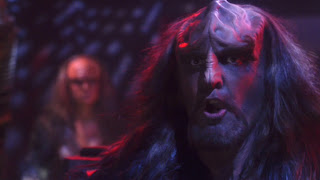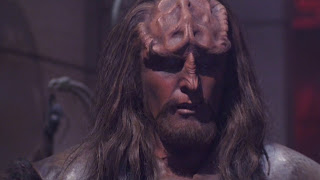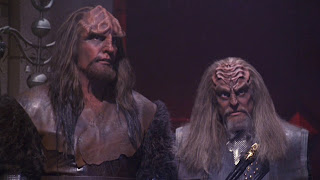I recently saw "The Changeling" for the first time. I had read summaries of it before, and basically knew what to expect -
V'Ger-lite - but I was pleasantly surprised with the quality of its execution. When Scotty was pronounced dead and it cut to a commercial my attention was captured. Sure, I knew Scotty would come back somehow, and I could guess that Nomad would be the one to bring him back, but somehow it still managed to be shocking. Scotty was dead! And perhaps in an even more daring move for which Nomad did not have a magic reset button, Uhura's mind had been erased!
I also enjoyed some of the camera work - particularly when the camera followed right along side Nomad
. On one hand it was smart from a technical standpoint because Nomad could appear to be floating without having to find some way to conceal the strings or rods that held him up. But from an aesthetic standpoint it created a very eerie almost claustrophobic feeling, a very real sense that this deadly device was roaming the ship just waiting to discover a reason not to spare the
Enterprise any longer.
Unfortunately, the show suffers from a minor, unforeseeable anachronism. It's everybody's favorite underdog (pun) planet (or not), Pluto.
The Problem with Pluto
When Kirk shows Nomad the Sol system, he pulls up a diagram that shows nine planets, including Pluto. You can see its irregular orbit traced out on the screen, passing inside of Neptune's.
Because we have grown up
knowing that Pluto is a planet, we find it hard to think of it any other way. We have an almost sentimental attachment to the planet. But the truth is the definition of planet is rather arbitrary, and historically was strongly influenced by our efforts to understand our solar system from the inside out, rather than from the outside in.
If we were to fly into a solar system from the outside, we would first encounter the many small icy bodies of the Oort cloud and the numerous "dwarf planets" that clearly would not have the same "status" as the larger bodies in more or less circular orbits closer to the Sun. Pluto and Charon would probably not even be given formal names by an extra-terrestrial intelligence looking in. At best they might receive some catalog number as two of the many small-ish items in our solar system.
Or to turn the situation around. In recent decades we have been able to detect planets in other star systems for the first time. Invariably the early discoveries were all of super-gas giants. Our detection methods were simply not refined enough to detect planets much smaller than that. But even as our methods of detection improve, it is unlikely we would ever identify and classify a Pluto-like object as a new planet. By the time Starfleet has explored so many "strange new worlds" - and under the guidance of the Vulcans who don't exactly cling to sentimental notions of anything - I simply don't believe that Pluto would be on any respectable 23rd century diagram of the Solar System. At best such diagrams would only appear deep in the historical archives.
In fact I would suggest this scene would be a fine candidate for being updated in the remastered Trek episodes. Using a more accurate - and perhaps better looking - display would eliminate the inconsistency.
Would Nomad Have Known?
The Nomad probe was supposed to have been launched in 2002. Would it have recognized Pluto as a planet or not?
An article over at SPACE.com has a fairly thorough discussion of
the history of the Pluto debate. The Kupier Belt was confirmed to exist in 1992. The International Astronomical Union (IAU) was compelled to re-examine Pluto's status. The article reports: "In early 1999, the IAU wrangled over giving Pluto dual status -- both as a planet and as a Trans-Neptunian Object, reflecting its distant location. The plan was dropped after a public outcry led to hundreds of e-mails to the IAU."
By the time the article was written in 2000 the general consensus among astronomers seemed to be that whatever Pluto is, it is not a planet. Popular opinion has clearly lagged behind, but I would imagine that a forward thinking individual such as Jackson Roykirk would have programmed Nomad with a more enlightened view of the solar system. So Nomad probably should have known that Pluto is not a planet, at least assuming that information wasn't stored in the damaged portion of its memory banks. But Nomad doesn't object to the diagram Kirk shows it.
Why it Matters - Sort Of
While the Pluto debate seems largely a matter of semantics, there are some (almost) important reasons for us to think clearly about the topic-reasons that are to some extent illustrated with this episode.
Nomad identifies its point of origin based on a description of a star system. Similarly the SETI program has often used representations of our solar system to convey to ETs what star system we live in. Pioneer 10 and 11 both have a plaque engraved with a diagram of our solar system, including Pluto. Similarly, transmissions from the Arecibo, Puerto Rico radio telescope have contained encoded data representing our solar system that include Pluto.
But as described above, ETs viewing our star system from the outside in would likely never consider Pluto to be a major planet. Does this mean they would conclude we aren't the star system they're looking for? Maybe not. After all, if eight of the nine planets match the description given, what are the odds that they won't recognize the overall pattern? At the same time, an intelligence with Nomad's demand for perfection may reject the match.
Some of these messages contain very rudimentary descriptions of the solar system - barely more than some dots of slightly different sizes representing the different planets. If the message says nine and the aliens see eight, what might they think? Well, hopefully they have enough sense to check for other evidence of intelligent life.
 In the courtroom sequences the ridge seems to be incomplete along the right-hand side of his face (our left). Looking at the screen captures from TrekCore you can see that it isn't likely that his hair is just covering the upper part of the ridge; the hair is actually deeper in his skull than the ridge.
In the courtroom sequences the ridge seems to be incomplete along the right-hand side of his face (our left). Looking at the screen captures from TrekCore you can see that it isn't likely that his hair is just covering the upper part of the ridge; the hair is actually deeper in his skull than the ridge.
 With no evidence of trauma or scarring it's hard to explain away as a battle injury, but I suppose that's a possibility. The real-world explanation would seem to be that sometime between the filming of the flashback and the courtroom scene the prosthetic was damaged and not repaired.
With no evidence of trauma or scarring it's hard to explain away as a battle injury, but I suppose that's a possibility. The real-world explanation would seem to be that sometime between the filming of the flashback and the courtroom scene the prosthetic was damaged and not repaired.